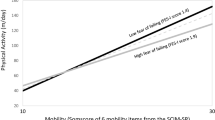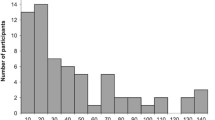Abstract
Background
Most studies of physical activity predictors in people with disability have lacked a guiding theoretical framework. Identifying theory-based predictors is important for developing activity-enhancing strategies.
Purpose
To use the World Health Organization’s International Classification of Functioning, Disability and Health (ICF) framework to identify predictors of leisure time physical activity among people with spinal cord injury (SCI).
Methods
Six hundred ninety-five persons with SCI (M age = 47; 76% male) completed measures of Body Functions and Structures, Activities and Participation, Personal Factors, and Environmental Factors at baseline and 6-months. Activity was measured at 6 and 18 months. Logistic and linear regression models were computed to prospectively examine predictors of activity status and activity minutes per day.
Results
Models explained 19%–25% of variance in leisure time physical activity. Activities and Participation and Personal Factors were the strongest, most consistent predictors.
Conclusions
The ICF framework shows promise for identifying and conceptualizing predictors of leisure time physical activity in persons with disability.
Similar content being viewed by others
References
Hicks AL, Martin Ginis KA, Pelletier CA, Ditor DS, Foulon B, Wolfe DL: The effects of exercise training on physical capacity, strength, body composition and functional performance among adults with spinal cord injury: A systematic review. Spinal Cord. 2011, 49:1103–1127. doi:10.1038/sc.2011.62
Martin Ginis KA, Jetha A, Mack DE, Hetz SP: Physical activity and subjective well-being among people with spinal cord injury: A meta-analysis. Spinal Cord. 2010, 48:65–72. doi:10.1038/sc.2009.83
Martin Ginis KA, Latimer AE, Arbour-Nicitopoulos KP, et al. Leisure time physical activity in a population-based sample of people with spinal cord injury part I: Demographic and injury-related correlates. Archives of Physical Medicine and Rehabilitation. May 2010, 91(5):722–728.
Craig CL, Cameron C: Increasing physical activity: Assessing trends from 1998–2003. Ottawa, ON: Canadian Fitness and Lifestyle Research Institute; 2004.
Wahman K, Nash MS, Lewis JE, Seiger A, Levi R: Cardiovascular disease risk and the need for prevention after paraplegia determined by conventional multifactorial risk models: The Stockholm spinal cord injury study. Journal of Rehabilitation Medicine. 2011, 43(3):237–242.
Myers J, Lee M, Kiratli J: Cardiovascular disease in spinal cord injury: An overview of prevalence, risk, evaluation, and management. American Journal of Physical Medicine and Rehabilitation. 2007, 86:142–452.
Baranowski T, Anderson C, Carmack C: Mediating variable framework in physical activity interventions. How are we doing? How might we do better? American Journal of Preventive Medicine. 1998, 15(4):266–297.
Biddle SJH, Nigg CR: Theories of exercise behavior. International Journal of Sport Psychology. 2000, 31:290–304.
van der Ploeg HP, van der Beek AJ, van der Woude LH, van Mechelen W. Physical activity for people with a disability: A conceptual model. Sports Medicine. 2004, 34(10):639–649.
WHO, World Health Organization: International classification of functioning, disability, and health (ICF). Geneva 2001.
Rimmer J. Use of the ICF in identifying factors that impact participation in physical activity/rehabilitation among people with disabilities. Disability and Rehabilitation. 2006, 28(17):1087–1095.
Warner G, Basiletti M, Hoenig H. Age differences in leisure physical activity by adult wheelchair users. Physical and Occupational Therapy in Geriatrics. 2010, 28(4):410–421.
Manns PJ, Chad KE: Determining the relation between quality of life, handicap, fitness, and physical activity for persons with spinal cord injury. Archives of Physical Medicine and Rehabilitation. 1999, 80:1566–1571.
Tawashy AE, Eng JJ, Lin KH, Tang PF, Hung C: Physical activity is related to lower levels of pain, fatigue and depression in individuals with spinal-cord injury: A correlational study. Spinal Cord. Apr 2009, 47(4):301–306.
Arbour-Nicitopoulos KP, Martin Ginis, KA. Physical activity correlates and determinants for persons with spinal cord injury: Limitations and future directions. In: TC Berkovsky (ed), Spinal cord injuries: Types, treatments, and prognosis. Hauppauge, NY: Nova Science Publishers; 2009, 593–610.
Martin Ginis KA, Arbour-Nicitopoulos KP, Latimer AE, et al. Leisure time physical activity in a population-based sample of people with spinal cord injury part II: Activity types, intensities, and durations. Archives of Physical Medicine and Rehabilitation. May 2010, 91(5):729–733.
Rimaud D, Calmels P, Devillard X: Reentrainement a l'effort chez le blesse medullaire. [Training programs in spinal cord injury] Annales de Readaptation et de Medicine Physique. 2005, 48(5):259–269.
Martin Ginis KA, Latimer AE, Buchholz AC, et al.: Establishing evidence-based physical activity guidelines: Methods for the Study of Health and Activity in People with Spinal Cord Injury (SHAPE SCI). Spinal Cord. 2008, 46(3):216–221.
Canadian Paraplegic Association. The Workforce Participation Survey of Canadians with Spinal Cord Injury Ottawa, ON Canadian Paraplegic Association; 2000.
Farry A, Baxter D. The incidence and prevalence of spinal cord injury in Canada: Overview and estimates based on current evidence. Vancouver, BC: Rick Hansen Institute; 2010.
Martin Ginis KA, Latimer AE, Craven BC, Hicks AL. Development and preliminary evaluation of an activity measure for people with spinal cord injury. Medicine and Science in Sports and Exercise. 2005, 37:1099–1111.
Martin Ginis KA, Latimer AE: Physical Activity Recall Assessment for People with Spinal Cord Injury (PARA-SCI): Administration and scoring manual. Hamilton, ON: McMaster University; 2008.
Cieza A, Kirchberger I, Biering-Sorensen F, et al.: ICF Core Sets for individuals with spinal cord injury in the long-term context. Spinal Cord. 2010, 48:305–312.
Ware JE, Jr., Sherbourne CD. The MOS 36-item short-form health survey (SF-36). I. Conceptual framework and item selection. Med.Care. 1992, 30(6):473–483.
Martin Ginis KA, Latimer AE, McKecknie K, et al.: Using exercise to enhance subjective well-being among people with spinal cord injury: The mediating influences of stress and pain. Rehabilitation Psychology. 2003, 48:157–164.
Kroenke K, Spitzer RL, Williams JB: The PHQ-9: Validity of a brief depression severity measure. Journal of General Internal Medicine. 2001, 16:606–613.
Bombardier CH, Richards JS, Krause JS, Tulsky D, Tate DG: Symptoms of major depression in people with spinal cord injury: Implications for screening. Archives of Physical Medicine and Rehabilitation. 2004, 85:1749–1756.
DeVivo M, Biering-Sorensen F, Charlifue S, et al.: International Spinal Cord Injury Core Data Set. Spinal Cord. 2006, 44(9):535–540.
American Spinal Injury Association. International standards for neurological classification of spinal cord injury. American Spinal Injury Association; 2002.
Dijkers MP, Yavuzer G: Short versions of the telephone motor functional independence measure for use with persons with spinal cord injury. Archives of Physical Medicine and Rehabilitation. 1999, 80:1477–1484.
Canadian Paraplegic Association: The workforce participation survey of Canadians with spinal cord injury. Ottawa ON: Canadian Paraplegic Association; 2000.
Whiteneck GG, Brooks C, Charlifue S: Guide for the use of the CHART: Craig Handicap Assessment and Reporting Technique. Craig Hospital: Englewood, Colorado; 1992.
Perenboom RJ, Chorus AM: Measuring participation according to the International Classification of Functioning, Disability and Health (ICF). Disability and Rehabilitation. 2003, 25(11–12):577–587.
Magasi SR, Heinemann AW, Whiteneck GG, Quality of Life/Participation Committee: Participation following traumatic spinal cord injury: An evidence-based review for research. Journal of Spinal Cord Medicine. 2008, 31(2):145–156.
Noonan VK, Miller WC, Noreau L: A review of instruments assessing participation in persons with spinal cord injury. Spinal Cord. 2009, 47(6):435–446.
Ajzen I: From intentions to action a theory of planned behavior. In: J Kuhl & J Beckmann (eds). Action control: From cognition to behavior. Heildelberg: Springer-Verlag, 1985, 11–39.
Latimer AE, Martin Ginis KA. The theory of planned behavior in prediction of leisure time physical activity among individuals with spinal cord injury. Rehabilitation Psychology. 2005, 50(4):389–396.
Latimer AE, Martin Ginis KA, Arbour KP. The efficacy of an implementation intention intervention for promoting physical activity among individuals with spinal cord injury: A randomized controlled trial. Rehabilitation Psychology. 2006, 51(4):273–280.
Blanchard CM, Courneya KS, Rodgers WM, et al. Is the theory of planned behavior a useful framework for understanding exercise adherence during phase II cardiac rehabilitation? Journal of Cardiopulmonary Rehabilitation. 2003, 23:29–39.
Courneya KS, Plotnikoff RC, Hotz SB, Birkett NJ: Predicting exercise stage transitions over two consecutive 6-month periods: A test of the theory of planned behaviour in a population-based sample. British Journal of Health Psychology. May 2001, 6:135–150.
Saelens BE, Sallis JF, Black JB, Chen D: Neighborhood-based differences in physical activity: An environment scale evaluation. American Journal of Public Health. 2003, 93:1552–1558.
Paralyzed Veterans of America. Outcomes following traumatic spinal cord injury: Clinical practice guidelines for health-care professionals. Paralyzed Veterans of America; 1999.
Wood-Dauphinee S, Exner G, The SCI Consensus Group: Quality of life in patients with spinal cord injury—basic issues, assessment, and recommendations. Restorative Neurology and Neuroscience. 2002, 20(3–4):135–149.
Kline RB: Principles and practice of structural equation modeling. New York: The Guilford Press, 2005.
Tabachnick BG, Fidell LS: Using multivariate statistics. vol 4th Boston, MA: Allyn and Bacon, 2001.
Arbour-Nicitopoulos KP, Martin Ginis KA, Latimer AE: Planning, leisure time physical activity, and coping self-efficacy in persons with spinal cord injury: A randomized controlled trial. Archives of Physical Medicine and Rehabilitation. 2009, 90(12):2003–2011.
Hagger MS, Chatzisarantis NLD, Biddle SJ: A meta-analytic review of the theories of reasoned action and planned behavior in physical activity: Predictive validity and the contribution of additional variables. Journal of Sport and Exercise Psychology. 2002, 24:3–32.
Scelza WM, Kalpakjian CZ, Zemper ED, Tate DG: Perceived barriers to exercise in people with spinal cord injury. American Journal of Physical Medicine & Rehabilitation. 2005, 84(8):576–583.
Coyle CP, Shank JW, Kinney WT, Hutchins DA: Psychosocial functioning and changes in leisure lifestyle among individuals with chronic secondary health problems related to spinal cord injury. Therapeutic Recreation Journal. 1993, 27:239–252.
Dattilo J, Caldwell L, Lee Y, Kleiber DA: Returning to the community with a spinal cord injury: Implications for therapeutic recreation specialists. Therapeutic Recreation Journal. 1998, 32:13–27.
Pentland W, Harvey AS, Smith T, Walker J: The impact of spinal cord injury on men's time use. Spinal Cord. 1999, 37;786–792.
de Groot S, van der Woude LH, Niezen A, Smit CA, Post MW: Evaluation of the physical activity scale for individuals with physical disabilities in people with spinal cord injury. Spinal Cord. Jul 2010, 48(7):542–547.
Acknowledgment
Research is supported by an Operating Grant from the Canadian Institutes of Health Research (MOP 57778) and a New Investigator Award (to KAMG) from the Canadian Institutes of Health Research. Manuscript preparation is supported by an Ontario Neurotrauma Foundation Mentor–Trainee Award (to KAMG and AEL).
We gratefully acknowledge Ms. Adrienne Sinden, M.Sc., for her assistance with manuscript preparation.
Conflict of interest statement
The authors have no conflict of interest to disclose.
Author information
Authors and Affiliations
Corresponding author
About this article
Cite this article
Ginis, K.A.M., Arbour-Nicitopoulos, K.P., Latimer-Cheung, A.E. et al. Predictors of Leisure Time Physical Activity Among People with Spinal Cord Injury. ann. behav. med. 44, 104–118 (2012). https://doi.org/10.1007/s12160-012-9370-9
Published:
Issue Date:
DOI: https://doi.org/10.1007/s12160-012-9370-9




